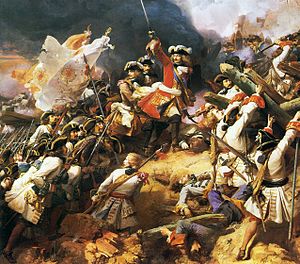Battle of Denain

Jean Alaux : Claude-Louis-Hector, duc de Villars at the head of the Régiment du Roi during the battle (historical painting from 1839)
| date | July 25, 1712 |
|---|---|
| place | Denain |
| output | French victory |
| Parties to the conflict | |
|---|---|
| Commander | |
| Troop strength | |
| 31 battalions of infantry, 24 squadrons of cavalry, a total of 18,000 men | 50 battalions of infantry, 40 squadrons of cavalry altogether 30,000 men |
| losses | |
|
about 6,400 men (1,800 killed, 500 used, 4,100 captured) = 34% |
about 2100 men (900 killed, 1200 used) = 7% |
Carpi - Chiari - Cremona - Kaiserswerth - Luzzara - Cádiz - Friedlingen - Vigo - Schmidmühlen - Ekeren - Höchstädt (1703) - Gibraltar - Speyerbach - Schellenberg - Bonn - Höchstädt (1704) - Vélez-Málaga - Cassano - Barcelona (1705) - Sendlinger Murder Christmas - Calcinato - Ramillies - Turin - Castiglione - Almansa - Toulon - Lille - Oudenaarde - Malplaquet - Almenara - Saragossa - Brihuega - Villaviciosa - Denain - Rio de Janeiro - Barcelona
The Battle of Denain took place on July 24, 1712 during the War of the Spanish Succession , essentially between French and Dutch units. It ended in a French victory. This was partly responsible for the withdrawal of the Netherlands from the war.
prehistory
After Great Britain had left the Hague Grand Alliance with the Netherlands , the Holy Roman Empire and the Habsburg countries and suddenly withdrew its troops on secret orders, the French Marshal Claude-Louis-Hector de Villars took the opportunity to launch an offensive.
A Dutch corps under General Arnold van Keppel, 1st Earl of Albemarle , was entrenched near Denain (in what is now northern France). Marshal Villars planned to take these positions. These intentions remained hidden from Eugene of Savoy , so that Villars could march unhindered to Denain.
course
When the enemy troops were at the site, this was also reported to Prince Eugene. Arnold van Keppel raised his troops. However, he had to do without defending the entrenchments on the right wing. Prince Eugene, who had arrived in the meantime, tried to compensate for this weakness with a few units, without being able to bring the main force of his army.
The French army had also formed in the meantime, with the infantry standing in front of the cavalry. The French attacked with infantry, grenadiers and dismounted dragoons . The dragoons stood in the first line on the French right wing. They advanced along the Scheldt on the left flank of the Allied position. The remaining French troops were grouped in two columns that advanced towards the center of the enemy. It was followed by a further thirty battalions in support, followed by the rest of the French army. The defenders had only six guns. The French answered the artillery fire from an elevated position.
Prince Eugene ordered the position to be held until the infantry of the left wing of the main Allied army had arrived. The French attack began at 1 a.m. It pushed back the opponents in the center, whose wings were cut off. Arnold van Keppel's attempt to get back on the offensive with the help of the left wing failed when these troops also fled. Van Keppel was captured by the French. The troops of Prinz Eugen, about 40 battalions strong, had meanwhile reached the Scheldt, but could not cross the river via an existing ship bridge because it was blocked and collapsed.
Arnold van Keppel's fleeing troops tried to swim across the river to escape the pursuing French. Apparently only a few have succeeded in this. Only about 4,000 men later returned to the army. Among the drowned were generals, Lieutenant General Count Dohna , who was in the Dutch service, and Sergeant General Count Cornelis von Nassau-Wondenberg . The French captured almost 3,000 men, including van Keppel and other high-ranking generals and officers.
consequences
After the victory, Villars managed to take a number of permanent locations. The victory was of great importance for the morale of the French troops. In particular, however, he played a role in the final breakup of the anti-French coalition, as the war-weary Dutch were ready to make concessions in the peace negotiations in Utrecht that were already underway. After the Peace of Utrecht in 1713, the Holy Roman Empire and Austria initially remained France's sole opponents of the war, before the war was ended in 1714 with the Peace of Rastatt and the Peace of Baden .
Individual evidence
- ↑ Gaston Bodart: Military-historical War Lexicon, (1618-1905) . Stern-Verlag, Vienna 1908, p. 167.
literature
- Hans Eggert Willibald von der Lühe: Militair-Conversations-Lexikon, Vol. 2 . Wigand Verlag, Leipzig, 1833, pp. 435–437.
- Gerhard Taddey (ed.): Lexicon of German history . People, events, institutions. From the turn of the times to the end of the 2nd World War. 2nd, revised edition. Kröner, Stuttgart 1983, ISBN 3-520-81302-5 , p. 242.